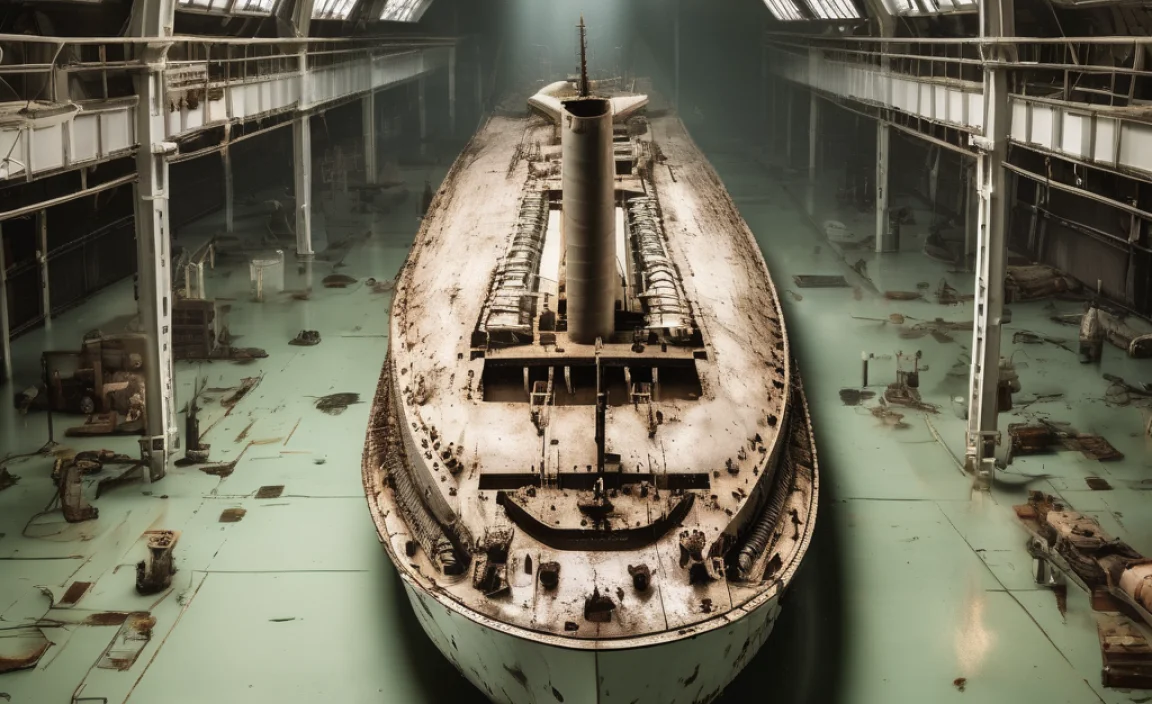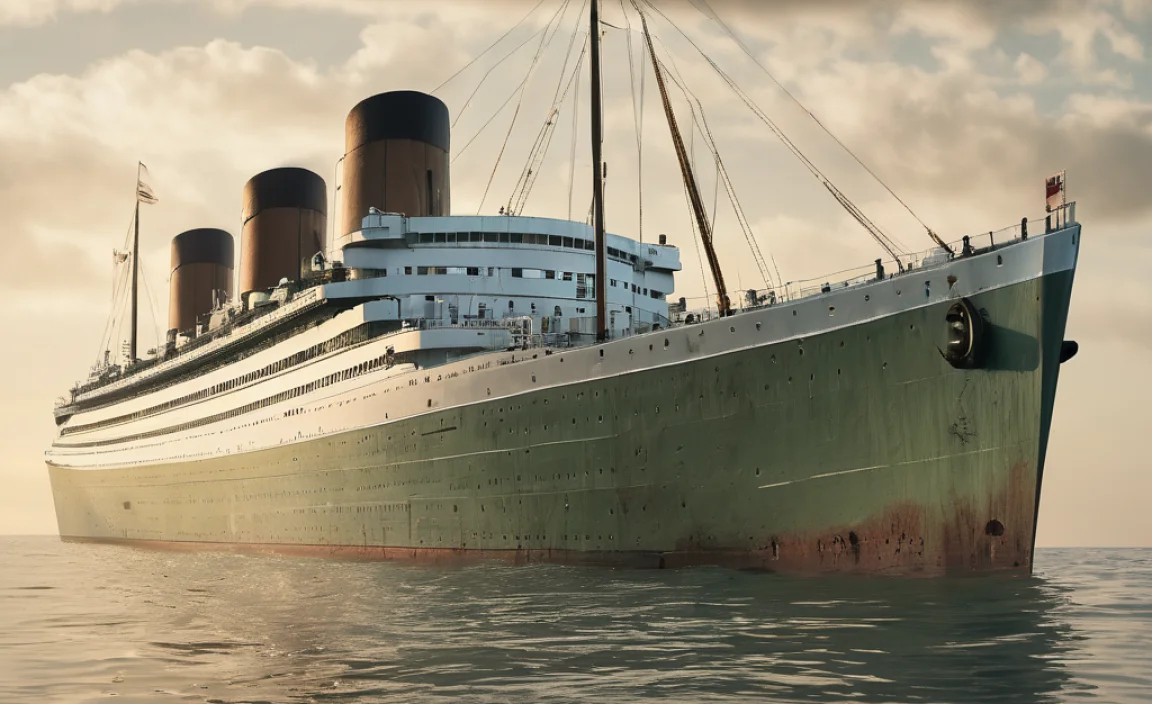Quick Summary:
The HMHS Britannic sank on November 21, 1916, after a powerful explosion ripped through its hull. While the exact cause is debated, most evidence points to striking a German mine in the Kea Channel off the Greek island of Kea. The damage caused rapid flooding, and the ship sank in less than an hour, claiming 30 lives.
Ever wondered what happened to the HMHS Britannic? It’s a fascinating, but tragic, story. The Britannic was intended to be a luxurious ocean liner, but it became a hospital ship during World War I. So, how did this massive vessel end up at the bottom of the Aegean Sea? Don’t worry; it’s not as complicated as it seems. We’ll walk you through the events step by step. Ready to learn the real story? Let’s dive in!
The HMHS Britannic: A Brief Overview

Before we get into the sinking, let’s cover some basics about the HMHS Britannic. Understanding its purpose and design will help explain why things unfolded the way they did.
What Was the Britannic?
The Britannic was the third ship of the White Star Line’s Olympic class, sister to the Olympic and the infamous Titanic. Originally intended for passenger service, World War I changed its fate. It was converted into a hospital ship, designated HMHS (His Majesty’s Hospital Ship) Britannic.
Key Facts About the Britannic
- Tonnage: 48,158 gross tons
- Length: 882.5 feet (269 meters)
- Purpose: Hospital ship during World War I
- Capacity: Over 3,300 beds for wounded soldiers
The Fateful Day: November 21, 1916

The events of November 21, 1916, unfolded quickly. The sinking of the Britannic was a rapid and chaotic event. Let’s break down the timeline.
The Morning of the Explosion
On that morning, the Britannic was sailing through the Kea Channel, near the Greek island of Kea. The ship was en route to Lemnos to pick up wounded soldiers. The weather was calm, and visibility was good. At 8:12 AM, disaster struck.
The Explosion
A massive explosion rocked the Britannic. Most believe the ship struck a German mine, part of a minefield laid by the U-boat U-73. The explosion occurred on the starboard side, between holds two and three. The force of the blast was tremendous, causing significant damage to the hull.
Immediate Aftermath
The explosion caused immediate and severe flooding. Several watertight doors failed to close properly, exacerbating the problem. Captain Charles Bartlett quickly assessed the situation and ordered the ship to be steered towards Kea, hoping to beach it. However, the rate of flooding was too rapid.
Why Did the Britannic Sink So Quickly?

Several factors contributed to the rapid sinking of the Britannic. Understanding these will help you appreciate the challenges the crew faced.
Failed Watertight Doors
One of the primary reasons for the rapid sinking was the failure of several watertight doors. These doors were designed to isolate compartments and prevent flooding from spreading. However, some of the doors were either not closed or malfunctioned. This allowed water to flow freely throughout the ship.
Open Portholes
Another critical factor was the presence of open portholes. Hospital ships often kept portholes open to ventilate the wards. After the explosion, the ship listed to starboard, submerging these open portholes and allowing even more water to rush in. The combination of the explosion damage and open portholes proved fatal.
The “Olympic” Class Design Flaw
The Olympic-class liners, including the Titanic and Britannic, had a design flaw that contributed to their vulnerability. The ships’ bulkheads (internal walls) didn’t extend high enough to the upper decks. This meant that if water reached a certain level, it could flow over the top of the bulkheads and flood adjacent compartments. This design flaw played a significant role in the Britannic’s rapid sinking.
Here’s a table summarizing the factors:
| Factor | Description | Impact on Sinking Speed |
|---|---|---|
| Mine Explosion | Caused significant hull damage on the starboard side. | Rapid initial flooding |
| Failed Watertight Doors | Some doors didn’t close or malfunctioned. | Allowed water to spread quickly |
| Open Portholes | Submerged as the ship listed, allowing more water in. | Increased the rate of flooding |
| Design Flaw | Bulkheads didn’t extend high enough, allowing water to flow over. | Accelerated flooding to other compartments |
The Evacuation

Despite the chaos, the crew managed to evacuate most of the people on board. The evacuation was a race against time.
Captain Bartlett’s Actions
Captain Bartlett’s quick thinking and decisive actions saved many lives. He ordered the ship to be steered towards Kea, hoping to reduce the distance to shore. He also gave the order to lower the lifeboats, though some were launched prematurely, before the ship had come to a complete stop.
Lifeboat Launches
Several lifeboats were launched while the Britannic was still moving. This resulted in two lifeboats being drawn into the still-turning propellers, causing them to be smashed. Tragically, this led to the majority of the 30 deaths that occurred during the sinking.
Rescue Efforts
Nearby ships responded quickly to the distress calls. Survivors were picked up by various vessels, including HMS Heroic and HMS Scourge. The rescue operation was efficient, and most of the crew and medical personnel were saved.
The Aftermath and Legacy

The sinking of the Britannic was a significant loss, but it also left a lasting legacy.
Casualties
Out of the over 1,000 people on board, 30 lost their lives. This was a remarkably low number, considering the speed at which the ship sank. The majority of the casualties were due to the lifeboats being struck by the propellers.
Discovery of the Wreck
The wreck of the Britannic was discovered in 1975 by Jacques Cousteau. The ship lies on its starboard side at a depth of about 400 feet (122 meters). The wreck is remarkably well-preserved, offering a unique glimpse into the past.
Diving the Britannic
Today, the Britannic is a popular dive site, though it is only accessible to experienced technical divers. The wreck’s size and depth make it a challenging but rewarding dive. Divers can explore the ship’s interior, observing the hospital equipment and other artifacts that remain.
Was it a Mine or a Torpedo?
While the consensus is that the Britannic struck a mine, some theories suggest it might have been a torpedo. Let’s examine the arguments.
Arguments for a Mine
- Location: The Kea Channel was known to be mined by German U-boats.
- Type of Damage: The damage was consistent with a mine explosion, which typically causes an upward blast.
- Historical Records: German records confirm that U-73 laid mines in the area.
Arguments for a Torpedo
- Eyewitness Accounts: Some survivors reported seeing a torpedo.
- Speed of Sinking: Some argue the speed of the sinking was more consistent with a torpedo hit.
The Verdict
Despite some eyewitness accounts, the overwhelming evidence supports the mine theory. The location of the explosion, the type of damage, and historical records all point to a mine as the cause of the sinking. The torpedo theory remains a minority view.
Lessons Learned from the Britannic
The sinking of the Britannic, like the Titanic, provided valuable lessons for maritime safety.
Improved Safety Measures
The disasters involving the Titanic and Britannic led to significant improvements in maritime safety regulations. These included:
- Increased Lifeboat Capacity: Ships were required to carry enough lifeboats for everyone on board.
- Improved Watertight Compartments: Watertight bulkheads were extended higher, and more reliable watertight doors were developed.
- Enhanced Communication Systems: Improved radio communication systems allowed for faster distress calls and rescue operations.
Better Training and Procedures
The importance of crew training and emergency procedures was also highlighted. Regular drills and clear protocols were implemented to ensure that crew members were prepared to handle emergencies effectively. These changes have significantly improved the safety of passenger ships.
Here’s a table that outlines the safety improvements:
| Area | Improvement | Impact |
|---|---|---|
| Lifeboats | Increased capacity to accommodate all passengers and crew. | Ensured everyone had a place in a lifeboat during emergencies. |
| Watertight Compartments | Extended bulkheads and improved door reliability. | Slowed down the rate of flooding and increased survival time. |
| Communication | Enhanced radio systems for faster distress calls. | Improved response times for rescue operations. |
| Training | Regular emergency drills and clear procedures. | Increased crew preparedness and effectiveness during emergencies. |
How to Learn More About the Britannic
Interested in delving deeper into the story of the Britannic? Here are some resources to explore.
Books and Documentaries
Several books and documentaries offer detailed accounts of the Britannic’s history and sinking. Some notable titles include:
- “Britannic: The Last Titan” by Simon Mills
- “Shadow of the Titanic: The Mystery of the Giant Olympic Class Liners” by Ric hard Davenport-Hines
- “Britannic” (1999 film)
Museums and Exhibitions
Various maritime museums and exhibitions around the world feature exhibits on the Britannic. These exhibits often include artifacts recovered from the wreck and historical photographs.
- Titanic Belfast (Northern Ireland)
- National Maritime Museum (Greenwich, UK)
Online Resources
The internet offers a wealth of information about the Britannic. Websites, forums, and online archives provide access to historical documents, photographs, and survivor accounts. Some useful websites include:
- Encyclopedia Titanica (encyclopedia-titanica.org)
- The Britannic Historical Society
FAQ: Unraveling the Mysteries of the Britannic
1. Was the Britannic larger than the Titanic?
Yes, the Britannic was slightly larger than the Titanic in terms of gross tonnage, but not significantly so.
2. How long did it take for the Britannic to sink?
The Britannic sank in approximately 55 minutes, much faster than the Titanic, which took about 2 hours and 40 minutes.
3. Why was the Britannic a hospital ship?
The Britannic was converted into a hospital ship during World War I to transport and care for wounded soldiers.
4. How deep is the Britannic wreck?
The Britannic wreck lies at a depth of about 400 feet (122 meters) in the Kea Channel.
5. Can you visit the Britannic wreck?
Yes, but only experienced technical divers can visit the wreck due to its depth and challenging conditions. Special equipment and training are required.
6. How many people died on the Britannic?
30 people died during the sinking of the Britannic, a relatively low number compared to the over 1,000 people on board.
7. What caused the explosion on the Britannic?
The most widely accepted theory is that the Britannic struck a German mine laid by the U-boat U-73.
Conclusion
The sinking of the HMHS Britannic remains a compelling and tragic event in maritime history. While the exact circumstances of the sinking are still debated, the evidence strongly suggests that a German mine was the culprit. The disaster led to significant improvements in maritime safety, ensuring that future ships would be better equipped to handle emergencies. The story of the Britannic serves as a reminder of the dangers of war and the importance of learning from past tragedies. So, next time you think about maritime history, remember the Britannic, the ship that was meant to heal but met a tragic end.

